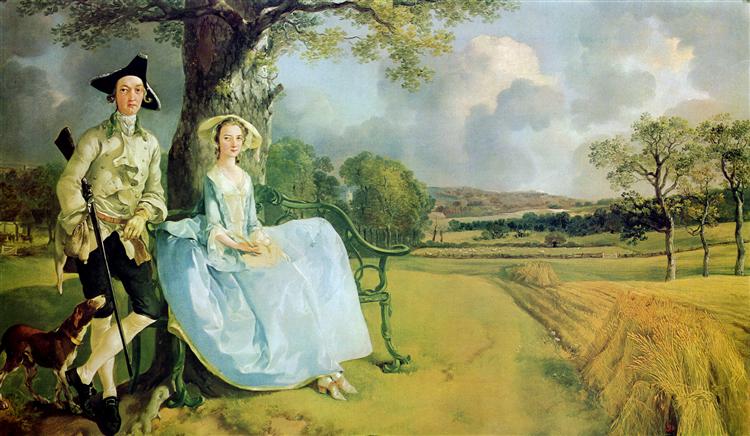Mr. and Mrs. Andrews
National Gallery, London, UK
Thomas Gainsborough, 1750
One of the most famous paintings by Thomas Gainsborough is the portrait Mr. and Mrs. Andrews (1750), which the artist painted when he was only 21 years old. The painting depicts the landowner Robert Andrews and his young wife Frances Andrews sitting on a bench in front of an English countryside landscape. The portrait was commissioned in 1750, two years after the couple married in the parish church of All Saints, Sudbury. However, the painting is not a marriage portrait, instead, it likely celebrated the inheritance Andrews received in 1750. Thus, the painting can be considered a ‘triple’ portrait – of Mr. Andrews, his wife, and his land. The couple is dressed casually, their attire is suited for an informal outing. Mr. Andrews is wearing a baggy shooting jacket with bags of powder and shot hanging from his pocket. He is holding a long-barreled shotgun and his dog is at his feet. Mrs. Andrews wears a simple light blue skirt and jacket, and a pair of casual heels. The portrait can be categorized as a ‘conversation piece’, a type of group portrait popular in 18th century England. The conversation piece is a kind of informal portrait: it usually depicts a group of family members or friends in a rural or domestic setting.In this early masterpiece, Gainsborough prominently features the naturalistic landscapes, that dominates the right side of the canvas. The artist was particularly fond of landscape painting, and in this case, he used the landscape to display his painterly skills. He creates the effect of changing weather, depicting stormy skies with patches of light and shadow that fall over the fields and meadows. This technique was common in Dutch 17th-century landscape painting, which influenced Gainsborough’s style of painting. This relatively small piece (69.8 cm × 119.4 cm) was typical of Gainsborough’s work in this early period. His later portraits such as Portrait of Colonel John Bullock (ca. 1780) and Mrs. Richard Brinsley Sheridan (1785-1787) were much grandeur and painted on larger, close to life-size formats. In these later works, the figure takes center stage, while the landscape in the background becomes more generalized.In the painting, Gainsborough left an unpainted patch in Mrs. Andrews's lap. The reason behind this is unknown: some speculate the artist planned to paint a cock pheasant in her lap, which her husband shot while hunting. Others suggest that space was reserved for a baby – the couple, who had nine children in total, had their first child only in 1751. If this was the intention, the portrait would celebrate Mr. Andrew’s authority as a landowner and husband. Mrs. Andrews died in 1780 at age 48, while her husband remarried and died in 1806 at age 80. The portrait was largely unknown to the public until it was displayed in an exhibition in Ipswich in 1927. After that, the painting regularly appeared in exhibitions across Britain and abroad. It remained with the family until 1960 when it was sold by Gerald Willoughbury Andrews (a great-great-great-grandson of the sitters). Today, the painting is in the National Gallery, London.
